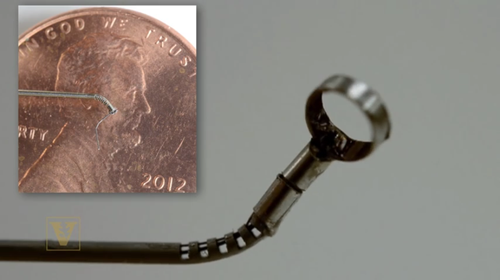Tiny Robotic 'Wrist' Has the Skill to Perform Brain Surgery
August 12, 2015

A team of engineers at Vanderbilt University in Nashville, Tenn. has used the multidisciplinary method of mechatronics to develop a tiny mechanical wrist that can be used to perform movements that need the utmost dexterity in needlescopic surgery procedures.
The wrist can have a variety of robotic and medical uses, but its primary function is as a part of a longer-term project to build a robotic system for removing brain tumors through the nose, an extremely delicate procedure, said Robert Webster, the project leader and associate professor of mechanical engineering at Vanderbilt.

“The robot has needle-size manipulators that can bend and elongate like tentacles,” Webster said. “The wrist itself is a more recent development to add dexterity at the tip of the device… While it was inspired by the larger project in trans-nasal surgery, we believe the wrist will also be useful in the future in a variety of different robots and even non-robotic hand-held tools."
Mechatronics basically combines mechanical and electrical engineering, but also can involve other aspects of engineering such as sensing and computing. Webster said the discipline is well-suited for developing new surgical tools such as the one he and his team developed.
MORE FROM DESIGN NEWS: 10 Technologies That Make Us Super-Human
Mechatronics is the combination of mechanical parts motors, and electronics,” he said. “In surgery, combining these things in the right ways let us project the skills of the surgeon down to scales far smaller than the human hand. Mechatronic systems also have the potential to help the surgeon do what he/she intended to do in surgery more accurately.”
The tool is called a “wrist” because it allows for the same type of movements a human wrist might do—such as bending and changing the direction of the hand—but in very tight spaces, Webster said. This inherently allows surgeons to perform their work with small incisions or in small cavities like the nose, making surgery less invasive.
“One of the big challenges in needlescopic surgery is that the tools are rigid and there is no way to reposition the instrument at the tool tip without angling the entire device,” he said. “Sometimes the surgeon does not have room inside the body to tilt the entire device enough to get at the piece of anatomy he or she wants to operate on.&rdrdquo;
This tilting requires a lot of space inside the body, Webster said, and creating that space means that either large incisions must be made, or healthy tissue that is in the way must be removed or pushed aside. “Less tilting means less damage to healthy tissue,” he said. This naturally results in less-invasive surgical procedures, Webster added.
MORE FROM DESIGN NEWS: A University Blends Mechatronics With Real-World Problem Solving
The device itself is of a fairly simple design, comprised of an outer elastic tube made of Nitinol, a nickel-titanium alloy, from which some material has been removed. A small wire uses a hand-operated lever or a standard DC motor to pull on the side of the tube, causing it to bend.
Webster and the Vanderbilt team are working on FDA approval for their invention and hope to find a partner to sell the product commercially.

We’re heading to Philly! Design & Manufacturing Philadelphia will take place Oct. 7-8. Get up close with the latest design and manufacturing technologies, meet qualified suppliers for your applications, and expand your network. Learn from experts at educational conferences and specialty events. Register today and join us at Philadelphia’s premier industry showcase!
Elizabeth Montalbano is a freelance writer who has written about technology and culture for more than 15 years. She has lived and worked as a professional journalist in Phoenix, San Francisco and New York City. In her free time she enjoys surfing, traveling, music, yoga and cooking. She currently resides in a village on the southwest coast of Portugal.
About the Author(s)
You May Also Like

.jpg?width=300&auto=webp&quality=80&disable=upscale)

